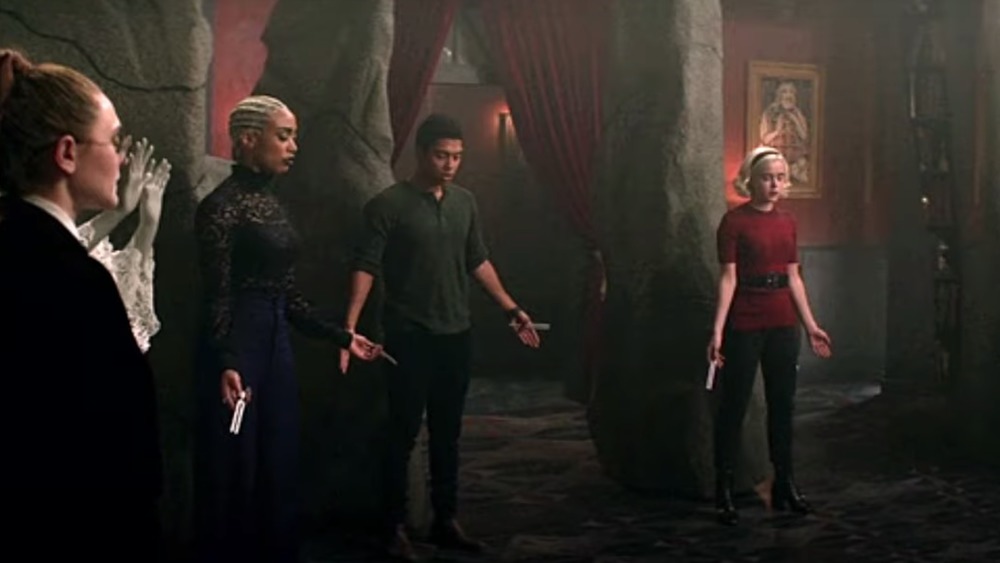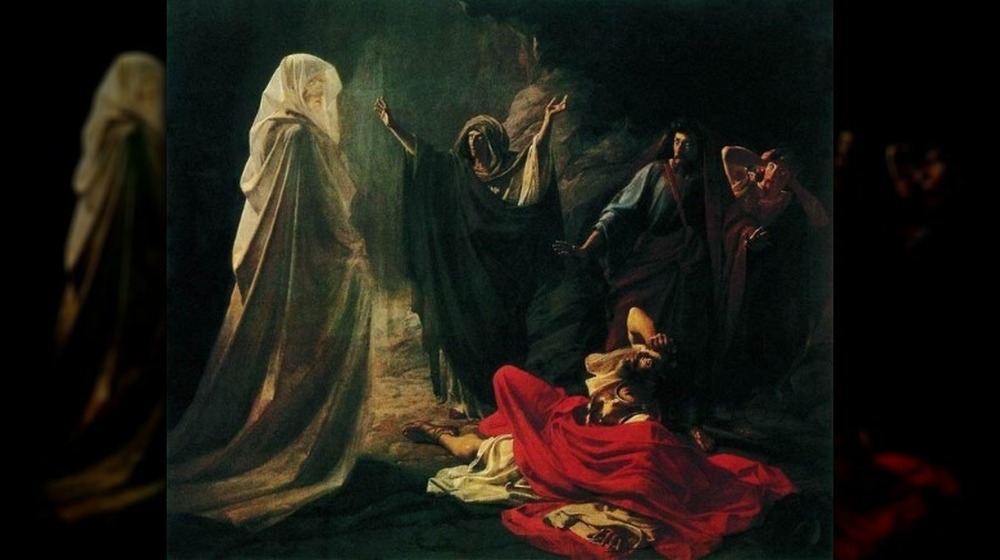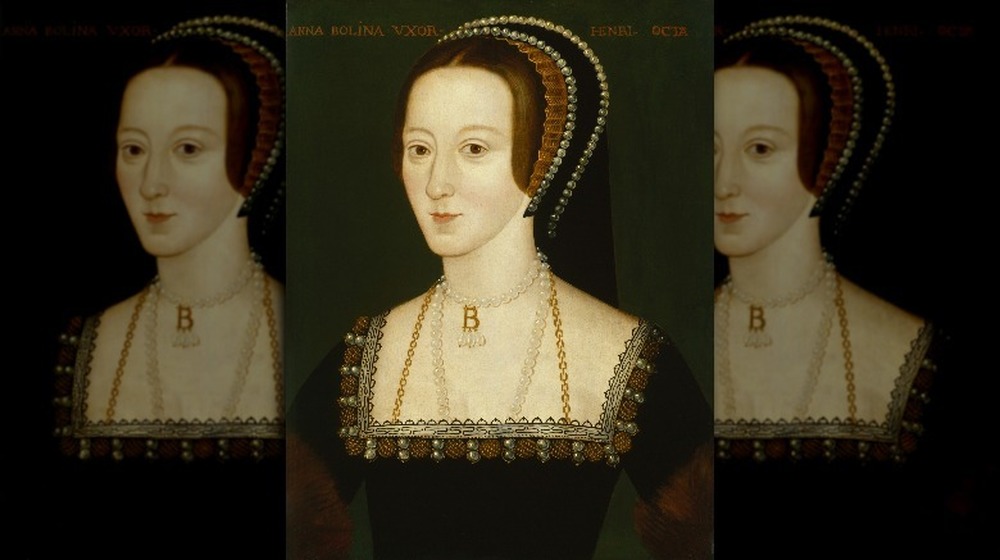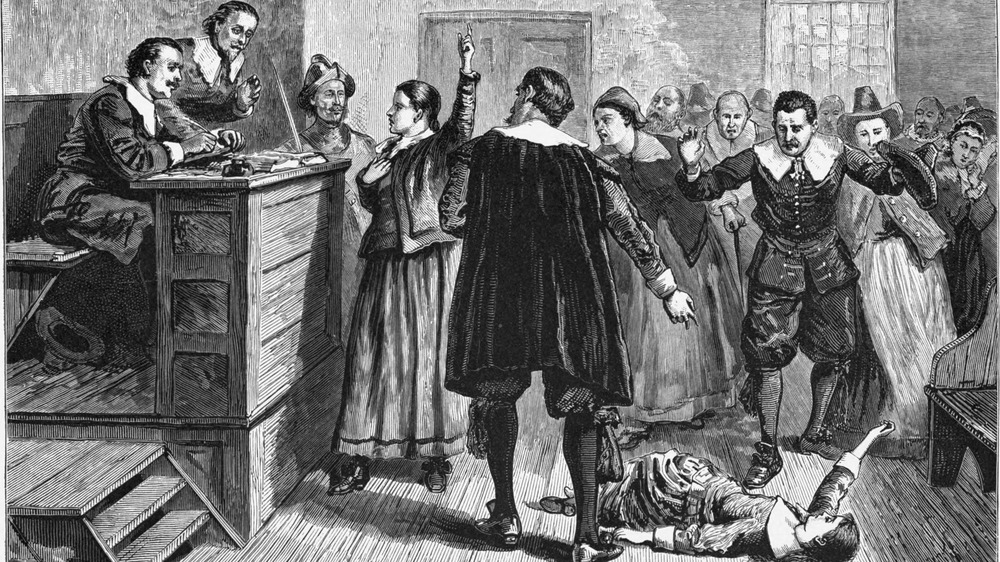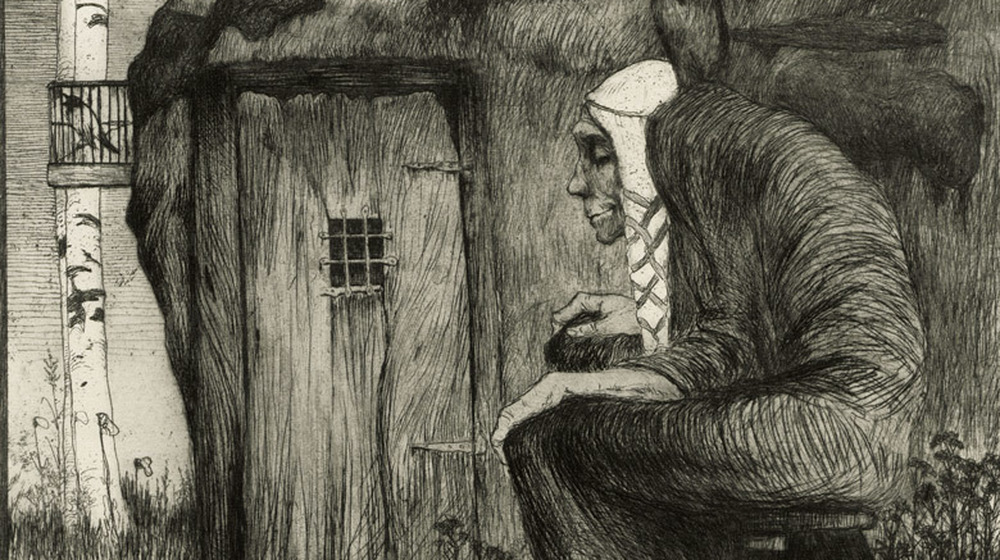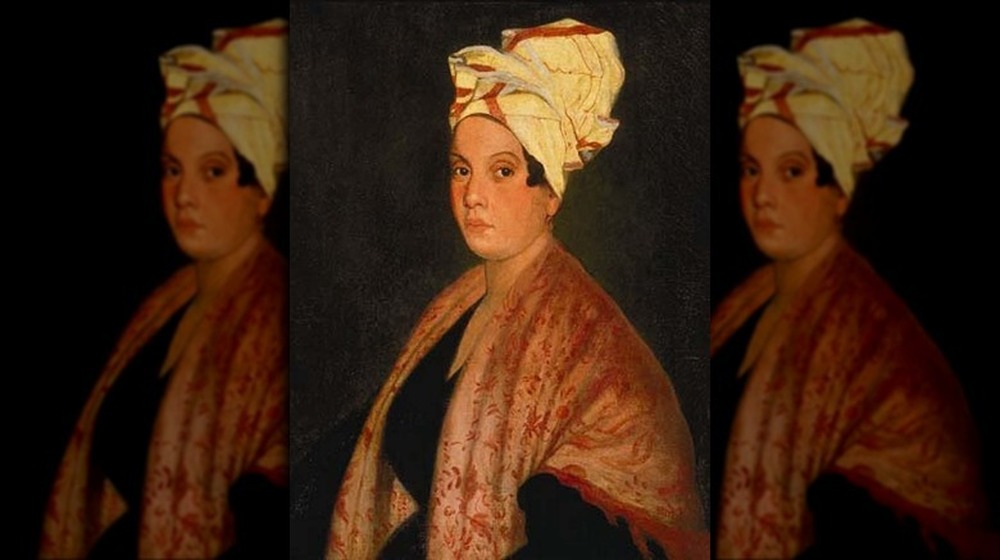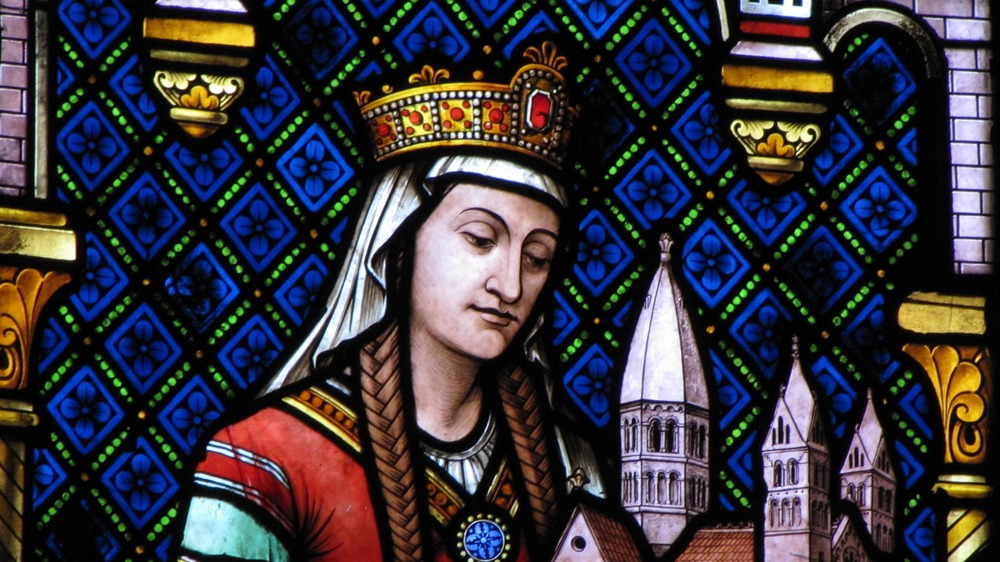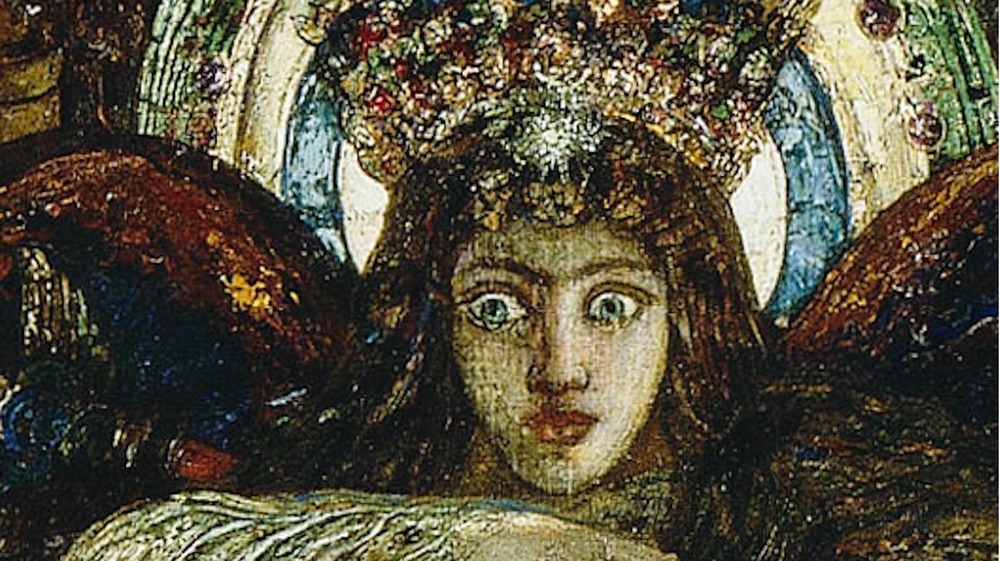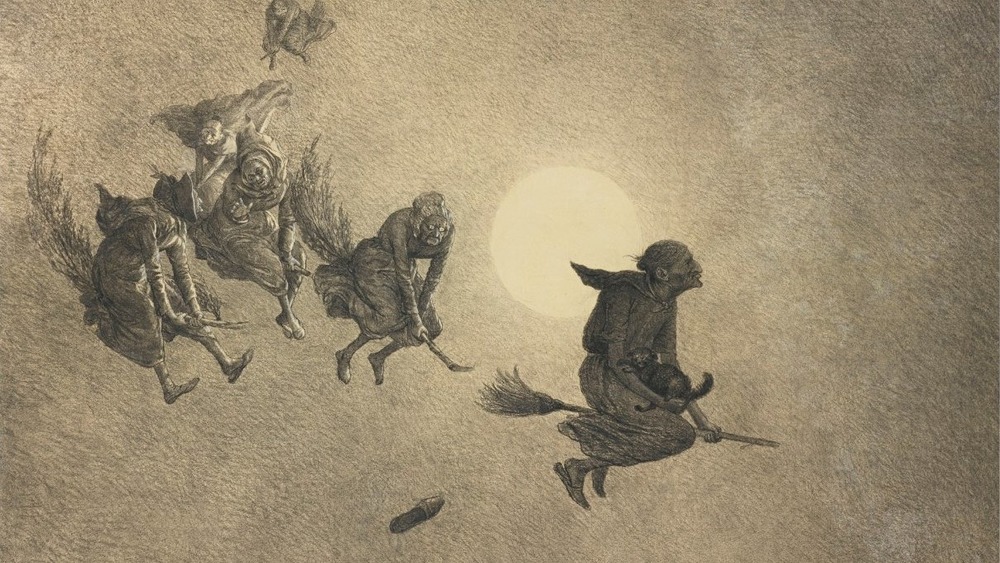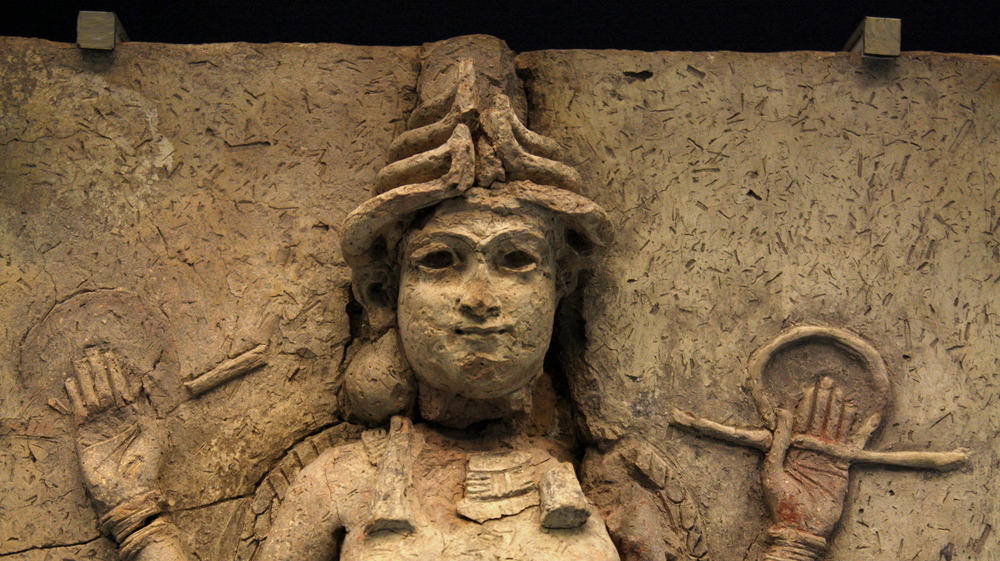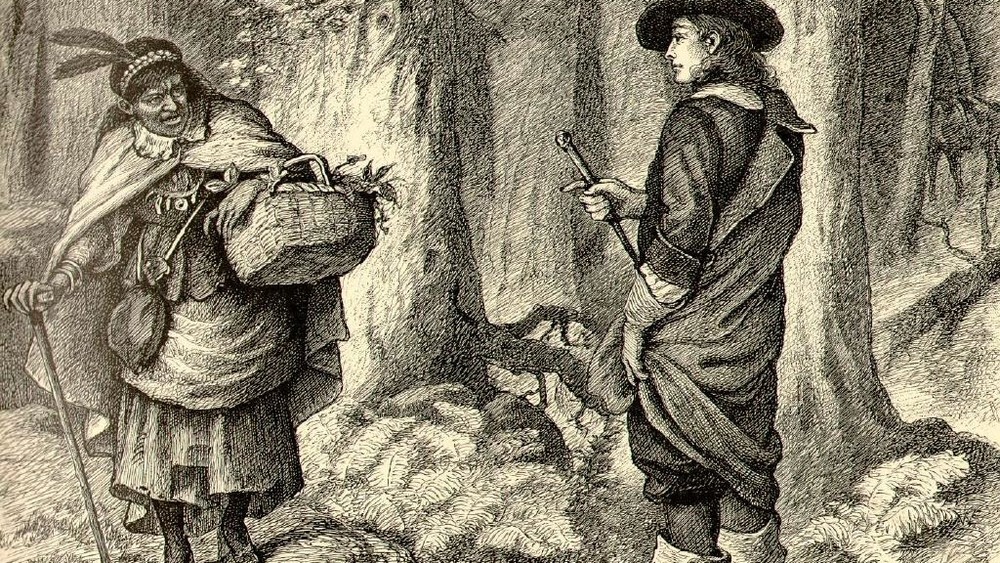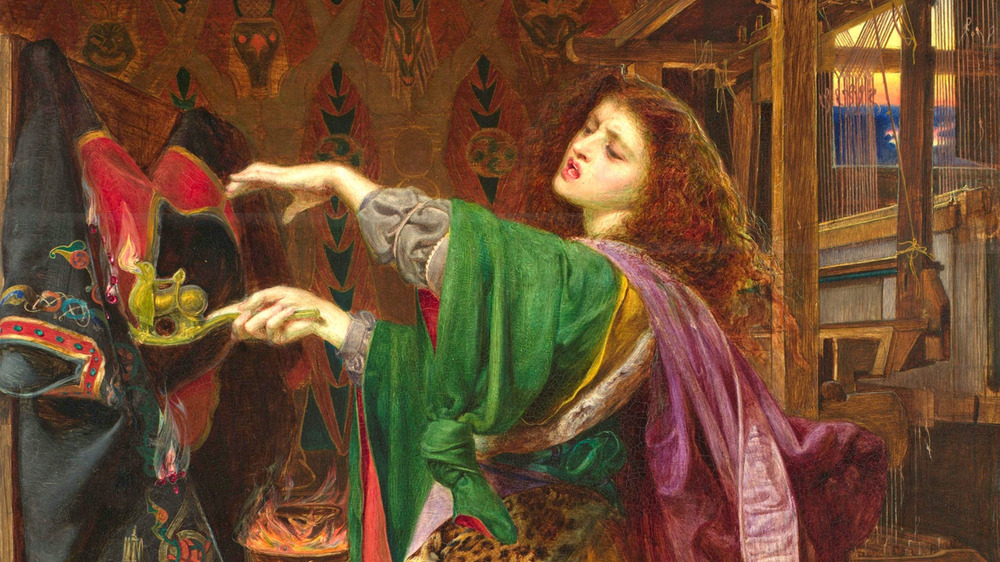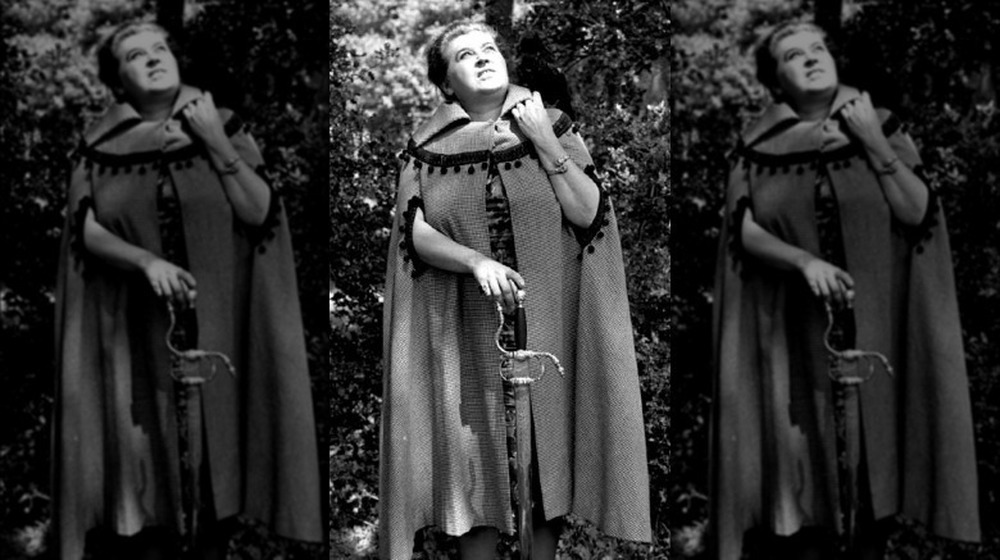The Real-Life Witches Behind The Chilling Adventures Of Sabrina
While The Chilling Adventures of Sabrina is a fictional creation, the show's creators have based quite a few of its concepts on real-world ties to witchcraft and the occult. They include real modern day pagans like production designer Lisa Soper, who told Refinery29 that some things like the show's sets, props, and spells are the real occult deal.
Witches, in fact, have been part of history for a very, very long time. They're arguably represented far back into human prehistory, according to the Journal of Archaeological Method and Theory. Consider all of the apparently ritual objects uncovered by excavators, some of which appear to have been destroyed as part of a religious ritual. More directly, named witches and magic workers show up fairly early in the historical records, says History. They include the mysterious Witch of Endor mentioned in the Bible's Book of Samuel, written some time between 931 to 721 B.C.E.
Some of these witches get a bit of air time on The Chilling Adventures of Sabrina. During season one's scene showing the exorcism of Uncle Jesse, Sabrina and her witch associates reference a number of witches, says Insider. Some of them, like Hecate and Artemis, are ancient goddesses. Others live in the realm of folklore. A few more, like modern witch Sybil Leek and Salem witch panic survivor Mary Bradbury, are very real people. Here are a few of those real-life witches behind The Chilling Adventures of Sabrina.
The Witch of Endor creeped out a Biblical king
The Witch of Endor's appearance in the Book of Samuel is pretty troubling for many religious leaders and Biblical scholars, precisely because she practices magic. More specifically, says the Jewish Encyclopedia, she practices "necromancy," a form of spirit-summoning where she calls upon the dead, as requested by King Saul of Israel. The fact that the Witch of Endor works her forbidden art in the service of a Biblical king is awkward, at best.
As related in 1 Samuel, Saul is actually the source of this awkwardness. Having gotten rid of all the magical workers from Israel, he now finds himself in need of help from God as an army is marching against him. But, God's apparently not speaking to him, so Saul seeks out the Witch of Endor in order to raise the dead prophet, Samuel. The witch is understandably suspicious, but Saul says he won't have her killed. She raises the dead prophet, who goes on to excoriate Saul and tell him that the army will overtake Israel. Saul's days as a king are numbered. Saul, who's been fasting, faints and eventually accepts his fate.
Britannica reports that, though her appearance is brief, the Witch of Endor has since become a fascinating figure for many. Medieval English poet Geoffrey Chaucer references her, while a later French writer colorfully — and without substantiation — claimed that the Witch of Endor even used a candle made out of her own son's fat.
Anne Boleyn wasn't directly accused of witchcraft
Most people who know the story of English queen Anne Boleyn rightfully consider her tale to be a tragic one. She caught the eye of King Henry VIII, who ditched his first wife and the Catholic Church in his quest to marry her. Yet, as The Guardian reports, Boleyn proved to be troublesome for all that she was witty and beautiful. She also never gave Henry his longed-for male heir. Thus, Boleyn was jailed on trumped-up charges of treason and eventually beheaded by order of the king.
In the years after her 1536 execution, the legend of Anne Boleyn has grown to include magic. She was actually never charged with witchcraft, though The Anne Boleyn Files argues that she has garnered something of a witchy reputation. Some contemporary rumors alleged that she had birthed a "monstrous" baby, often said to be evidence of consortation with the Devil. So, too, was Henry's alleged issues in the bedroom, along with Boleyn's supposed "libertine" behavior both before and after her marriage to the king. Some even claimed that Boleyn was physically marked by eerie forces, sporting a sixth finger on one hand, an ugly cyst on her neck, and a projecting tooth. Yet, as History reports, these claims about her supposedly evil witch body were all made in the decades after her death. None of her contemporaries ever mentioned these, so it's safe to assume that the real Anne Boleyn probably had the normal number of fingers.
Mary Bradbury escaped death in the Salem witch trials
Panic can grow deadly. That's what Mary Bradbury surely understood by the end of the 1692 witch panic in Salem, Mass. According to Genealogy Magazine, she was related to some well-connected people and was known to be "full of works of charity and mercy to the sick and poor," as Rev. James Allen testified. Yet, she also appeared to have butted heads with the Carr family. Little wonder, then, that she was accused by Ann Putnam, a Carr relative.
Bradbury's troubles began on May 26, 1692, according to the Salem Witch Museum. She was accused of attacking people in her spectral form, while some of those who spoke against her claimed to see Bradbury's uncle appear in his burial clothes, accusing his niece of murdering him. Bradbury was sentenced to hang on September 9, despite the arguments of her family and friends. When their support didn't work in court, they helped her escape the jail, after which she lived as a fugitive until the trials lost their fervor. Bradbury returned to her family in May 1693.
After her death, her family asked for a reversal of the charges, which was granted in 1710. Like practically everyone else accused in the trials, there's no real evidence supporting the notion that Bradbury was a witch, much less someone with the power to bring death and destruction through magic.
Black Annis is a terrifying folklore witch
Though many parents have likely comforted a terrified child by telling them that Black Annis is only a story, this folkloric British witch is surely still a bit too real for some people. The tales of her bloody exploits are utterly terrifying, not least because she reportedly has a penchant for human flesh. According to the legends related at White Dragon, she is said to live in a cave somewhere in the hills outside of Leicester, England. She steals away children and eats them almost entirely, saving the skins for clothing and decoration. Some say that she can still be heard howling amongst the hills, while that awful grinding sound is the gnashing of her teeth.
According to the BBC, there's a chance that the legend of Black Annis is based on a real person. The story goes that her tale might be connected to a medieval Dominican nun named Agnes Scott, who wore a black habit that was characteristic of her order. Scott reportedly helped the sick and homeless around Leicester, but, after her death in 1455, she became a frightful figure used to scare naughty children. Some also wonder if Scott became conflated with an older, darker set of tales focusing on a harsh goddess, harkening back to a wilder pagan time.
Marie Laveau was a formidable New Orleans witch
Unlike other witches mentioned on The Chilling Adventures of Sabrina, Marie Laveau was a real person living in 19th century New Orleans. In fact, she was actually two people, a mother and daughter with the same name, who were both well known as Voodoo practitioners and powerful magic workers.
Little about the occult side of their work is well-documented, but various accounts insist that they were powerful magical workers. The elder Laveau was born in September 1801, Louisiana History reports. She was a free woman of color, generally believed to be of African, Native American, and white descent. As another article in Louisiana History relates, she ultimately became a widely recognized hairdresser, healer, and herbalist who also practiced Louisiana Voodoo, a spiritual belief system strongly influenced by African beliefs brought over by enslaved peoples.
Her daughter, generally known as Marie Laveau II, often held dramatic public rituals. Both of these women exercised considerable influence and power, leading to the now famous image of Marie Laveau as the "Voodoo Queen" of New Orleans. One of the last people to see the elder Laveau before her death, as quoted in The Magic of Marie Laveau, said that "One but had to look at [Marie Laveau II] and impute her brilliances ... to her mother, and remember what New Orleans was long years ago, to understand how the name of Marie Laveau should have driven herself inextricably into the traditions of the town and the times."
Hildegard of Bingen was a boundary-breaking medieval nun
The invocation of Saint Hildegard of Bingen was a controversial move for some. As a few users on Facebook pointed out, this was at least a little awkward, considering that Hildegard was a Christian nun. Yet, she was also a boundary-pushing mystic whose indelible voice echoes down throughout history, despite the sexism of her time and the sheer number of centuries between people today and Hildegard.
According to the Ancient History Encyclopedia, Hildegard was a Benedictine abbess who lived in 11th and 12th century Germany. She was, to all appearances, a brilliant woman who not only experienced ecstatic visions of God but was also an accomplished writer, musician, herbalist, philosopher, and early scientist. She often wrote of the importance of nature, which she believed revealed God's presence, and of a feminine divine force that was surely shocking to people of her time.
Though few would truly argue that Hildegard was a pagan witch, her story does have a certain kind of transgressive witchiness about her. Author Mary Sharrat argues that Hildegard has certain similarities with later women accused in England's 1612 Pendle witch trials. Both the nun and one of the British women, "Mother Demdike," were guided by visions and a deep, spiritual connection to nature. They were also women who pushed against the gender boundaries of their times, though Hildegard rose to power within the church and Mother Demdike died in jail.
Hecate was a Greek goddess of witchcraft who is still worshipped today
The Greek gods and goddesses were, in general, a group of complicated and often misbehaving deities whose stories still resonate with modern people. Yet, the tale of the goddess Hecate is arguably a far sight more intricate than those of her fellow gods. And, for many even today, she's still a very real goddess who's worthy of worship.
Hecate, as per the Ancient History Encyclopedia, is a dark goddess associated with crossroads, thresholds, nocturnal animals, the moon, and, of course, magic. Because or her connections to the underworld and nighttime, she was an unusual goddess who was propitiated with offerings that were forbidden to other worshippers, like certain meats. She's often depicted carrying torches and keys and sometimes strikingly appears with three heads.
According to The Encyclopedia of Witches, Witchcraft, and Wicca, Hecate is still venerated by modern witches, thanks to her association with magic, the moon, and the concept of the Triple Goddess. She's often invoked in association with a specific moon phase and for matters like introspection, banishment, and justice.
Moll Dyer is a legendary Maryland witch
Some may doubt the existence of Moll Dyer, but a particular stone near her supposed home of Leonardtown, Md., makes things a bit tricky for skeptics. Could it be that Moll Dyer was once a real person?
According to Weird Maryland, the stories say that she was a woman who lived in Maryland in the late 17th and early 18th centuries. Dyer was already something of an odd duck. If someone's livestock grew ill or their butter didn't churn, it was said that Dyer was to blame. When an epidemic hit town, a mob chased after her. She placed her hand on a rock and prayed for help that never came.
After her death, people saw the indelible print of her hand in the stone. Today, you can still see the stone, which does look a bit like someone's left an imprint of their hand there. Those who touch it sometimes report feeling nauseous, as if they were briefly in Dyer's place.
So, was Moll Dyer real? As per The Washington Times, there are indeed reports of witchcraft in Maryland's colonial past. At least 12 people have been officially accused of witchcraft in the state's history, with one woman, Rebecca Fowler, hanged for the charge in 1685. The last recorded trial for this supposed crime took place in 1712. Yet, there's no record of anyone named Moll Dyer. If she existed, Dyer managed to escape the official accounts.
Lilith is a legendary demon still feared by some people
Lilith is very, very old. According to Jewish folklore, in fact, she's so incredibly old that Lilith was around at the very beginning of things, even before Eve — of Adam and Eve fame — made her debut. As per Britannica, tradition holds that Lilith was Adam's first wife, made from the same soil as he. When she refused to submit to him, Lilith vacated the Garden of Eden and became a demonic figure. Many versions of the tale maintain that she's the mother to many, many demons, with some legends claiming that they are Adam's children (sired during a separation from Eve), while others say that Lilith mated with a wayward archangel.
Though many have come to believe that Lilith is an evil figure, others have venerated her. As the Biblical Archaeology Society reports, she's been adopted by many feminists as a symbol of rebellion and independence. She's also a part of some real life witches' magical practice, as the Museum of Witchcraft and Magic points out with its discussion of a sigil, or magical sign, used by modern witches to connect to Lilith. No wonder, then, that her name is called upon in The Chilling Adventures of Sabrina, in a scene where a group of magical women seek to fight an ancient demon known as Apophis.
Tituba was caught up in the Salem witch trials
Many accounts of the Salem witch panic of 1692 begins with Tituba. As ThoughtCo relates, Tituba was a slave of Rev. Samuel Parris, Salem's resident minister. Not much is known of her background, though it appears that Tituba was born in the Caribbean, as she accompanied Parris from his previous home in Barbados.
When three young girls in the village, including Parris' own daughter Elizabeth, began to show signs of a mysterious and spiritually induced "affliction," Tituba quickly became embroiled in the controversy. The girls said Tituba tormented them in spirit form. She was arrested and questioned, perhaps violently, and confessed that she was a witch who had consorted with the Devil. When she recanted, Parris refused to pay the fine that would have freed Tituba from jail. She was eventually released, apparently by someone else, and then promptly disappears from the historical record.
Why did Tituba confess and only draw herself deeper into the deadly crisis? No one is really sure, Smithsonian Magazine says. Her testimony, which included tales of night flights, of menacing animals, and, of course, of a smoothly compelling Satan himself, must have held the terrified townsfolk in a horrified rapture. Perhaps, in a way, this was a moment of power for a woman who must not have had much at all in her day-to-day life.
Morgan Le Fay caused witch trouble for King Arthur
In the world of King Arthur and his legendary court of Camelot, there's always a villain. It simply wouldn't be a very compelling story if the good guys didn't have to go up against a baddie or two. And, with a malefactor like Morgan Le Fay stalking through the story, it's honestly hard to go wrong.
There are actually quite a few versions of the enchantress Morgan le Fay in Arthurian legend, as Britannica reports. Geoffrey of Monmouth, writing in the 12th century, said that she wasn't so bad and ruled over Avalon, a mystical island. A dying Arthur is said to have been carted off the battlefield and onto a boat bound for Avalon, where Morgan Le Fay was to use her magic to heal him.
Chretien de Troyes, whom Elke Dalecky reports wrote some of the first known Arthurian legends in the 1100s, also focuses on Le Fay's benevolent side. Yet, later retellings paint her as a darkly complicated or even downright evil witch. She creates discord between Arthur and his queen, Guinevere, acts as a temptress, and effectively worships demons in an increasingly Christian retelling of her world. Sometimes she's a half-sister to Arthur and, shockingly, also the mother to his son Mordred. Yet, regardless of whether Morgan Le Fay is kind, evil, or somewhere in between, she's always supremely powerful.
Sybil Leek was a famous modern witch
While some of the witches mentioned in The Chilling Adventures of Sabrina are legendary, Sybil Leek was very definitely real. She was a fixture of the occult world in the 20th century, to the point where she wrote numerous books and appeared on television in her quest to bring the practice of witchcraft to wider recognition.
As the BBC reports, Leek was once known as "Britain's most famous witch" for her championing of modern witchcraft. The United Kingdom had only just repealed the Witchcraft Act, which criminalized the practice of witchcraft, in 1951. A few years later, Leek announced that she was a witch. When her landlord declined to renew her lease, Leek moved to the United States and continued promoting her work, soon becoming well known worldwide for her practice as a well-intentioned "white witch."
Though she was one of an emerging group of public witches, Leek claimed that her family had been practicing magic since the 12th century, according to The New York Times.
